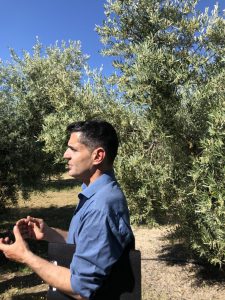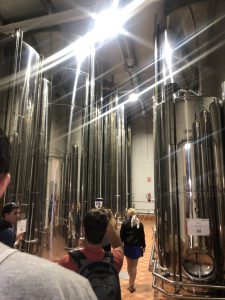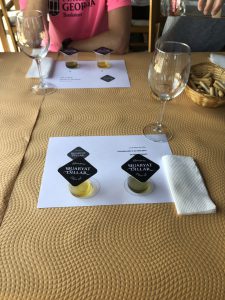Even though I’m not exactly interested in crop growing, I was surprised at how interesting I found the olive farm to be. I think the only experience I’ve had with olive oil is when it is served with bread at an Italian food restaurant. I’m not a very ambitious cook, so I had never cooked with it either. But Spain runs on olive oil! I could not have imagined the amount of thought, planning, and tasting experience that goes behind olive oil production. The olive farm itself was in a beautiful area surrounded by mountains. Our guide of the farm was very passionate about his work and it was interesting to hear his story. One thing he majorly emphasized is that the factory is in the field not in the building where it is created, bottled, and shipped out. The highest amount of care of the crop begins at the very beginning. Olive trees have wild varieties that grow all over Spain, but these specific trees have the balanced amount of greenery to let the sun come in and keep the plant healthy and producing olives. The trees are harvested traditionally in the winter or earlier, when the olives are green and they produce more intense attributes to the aroma and taste. Because the southern region of Spain is pretty arid, the trees are adapted to being in dry environments and do not require a lot of watering. However, there is a small watering line that is connected to underground currents that drip water to the trees. I learned that the extra virgin olive oil contains all of the health benefits of antioxidants while virgin has a less perfect balance of components. One of the most impressing things to me was that this farm was very careful about its waste products. When the olives are shaken from the trees, the leaves have to be separated out and the leaves are sent to another farmer who feeds these to his goats. The water that is used for washing the olives is thrown back out into the field. The pits of the olives are separated out and actually are dried out and used to heat the production building in the winter by burning the pits. Also, the skins of the olives are picked up by another company that will ferment the skins and use this fermentation to make electricity! It was all very interesting how nothing is gone to waste. We also learned how to taste olive oil and what qualities to look for. Generally, they are ranked on aroma, taste on the tongue, and bitterness in the throat. I made sure to buy a bottle to bring home so I can learn to cook with it and get those good antioxidants!
A website from the College of Agricultural and Environmental Sciences

Student blog




